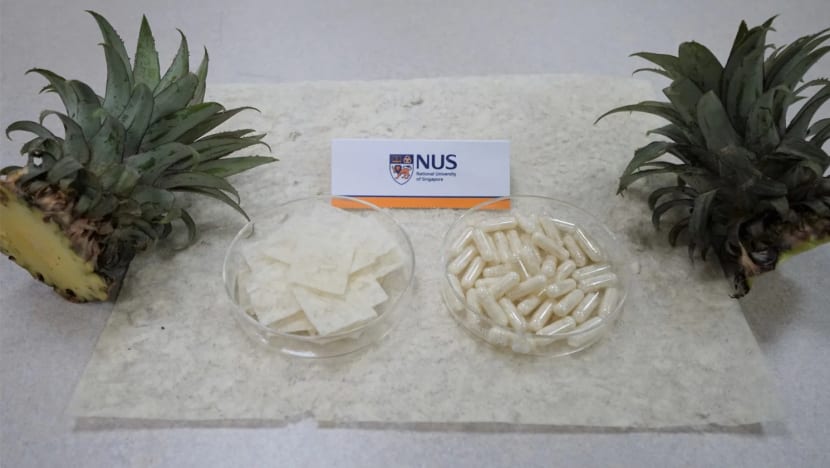NUS researchers upcycle pineapple leaves into low-cost fat trappers

Fat-trapping crackers and capsules made from pineapple leaf fibres. (Photo: NUS)
SINGAPORE: Pineapple leaf fibres could hold the key to cheaper weight-loss supplements with the added benefit of being greener and more sustainable for the environment.
The National University of Singapore (NUS) on Tuesday (May 17) said that its researchers have developed a method to use these cheap and abundant fibres to absorb fat.
These upcycled, fat-absorbing pineapple leaf fibres could take the form of capsules or crackers.
Utilising this part of the fruit, which is usually discarded during the harvesting process, also helps to reduce agricultural waste, said research team leader Associate Professor Duong Hai-Minh.
"In our recent work, we capitalised on the excellent mechanical properties of pineapple leaf fibres for fat absorption, a high-value application. Together with our earlier work of using pineapple leaves for production of highly absorbent aerogels, our goal is to help reduce agricultural waste and increase profits of farmers."
The production method developed by the NUS team is also "very cost effective", added Assoc Prof Duong, who is also from the Department of Mechanical Engineering under the NUS College of Design and Engineering.
HOW DOES IT WORK?
After ingestion, the capsule or cracker absorbs fatty compounds such as animal fats and form fat-coated fibre lumps.
These fat-coated lumps will then be passed out from the digestive system in one to three days, similar to other foods we consume, said research team member Associate Professor Phan Toan Thang, who is from the Department of Surgery under the NUS Yong Loo Lin School of Medicine.
In laboratory tests that simulate the acidic condition of the human digestive tract, the NUS team found that one gram of pineapple leaf fibres can absorb 45.1 grams of cooked fats and 20.4 grams of human fats.
“Based on our test results, you will need less than one capsule of pineapple leaf fibres to absorb the saturated fats from eating one hamburger,” said Assoc Prof Duong.
The approach proposed by the NUS team could be used for other types of cellulose fibres, such as sugarcane bagasse or pulp and coffee grounds.

Among Singapore residents aged 18 to 74, an estimated 35.5 per cent have high blood pressure while 39.1 per cent have high cholesterol, said NUS, citing a 2020 Health Ministry National Population Health Survey.
A healthy, low-fat diet as well as appropriate weight loss for obese individuals could help to lower the risk of such cardiovascular diseases, it added.
The global market size of weight loss supplements was valued at US$33.4 billion in 2020, and it is projected to expand at a compound annual growth rate of 16.6 per cent from 2021 to 2028.
Common ingredients in such dietary weight-loss supplements include chitosan, chromium picolinate, conjugated linoleum acid and green tea extract.
"There is a lack of scientific evidence to support the effectiveness of such fat-trapping supplements. Most fat trappers or fat burners are also expensive – some regimens could cost several hundred dollars a month," said the university.
The NUS team has filed a patent for this novel application of pineapple leaf fibres, and is looking for commercial partners to commercialise the technology.
















